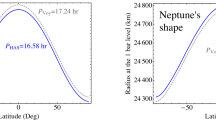Abstract
Evidence on the issues of whether the W Serpentis stars are a coherent class, and how they may interface with the Algol systems, is reviewed, with emphasis on the idea that they are semi-detached systems in the latter part of the rapid phase of mass transfer, with optically and geometrically thick disks of transferred gas around the (now) more massive star. We are interested in what will be seen when the gas clears away, and mainly examine the idea that it will be an Algol-type system. More particularly, consideration is given to centrifugally limited accretion as a mechanism to build up a substantial disk, and the presumed evolutionary sequence is from a W Ser to a rapidly rotating Algol to a normal Algol system. Systems such as V367 Cyg and RW Tau fit into this scheme only with difficulty. Because it is extremely difficult to measure the rotation of some W Ser (mass) primaries, it is natural to look at the rotation statistics of Algols to test this idea. The badly behaved light curves and spectroscopy of some Algols (eg. U Cep, RZ Sct) may be attributable to the double contact condition, and the ramifications of this possibility are discussed. If so, the rotation statistics of Algols should show two spikes, corresponding to the two special conditions into which a system should be driven by tidal braking and centrifugally limited spinup. Present rotation statistics do show these spikes. Algols should flip between these states fairly quickly, depending on the mass transfer rate. Thus, to the extent that the meager statistics can be accepted as meaningful, the new (fourth) morphological type of close binary (double contact) has attained demonstrable reality. The rotation statistics are presented in terms of a particular rotation parameter, R, which is zero for synchronism and unity for the centrifugal limit. Future work should develop rotation statistics to see if the rotational lobe-filling (R = 1) spike persists. It should also look into whether W Ser primaries are on the hydrogen burning main sequence, or in general what they are. We also need more light curves of W Ser type systems, high resolution line profiles for the (mass) primaries (with particular attention to the W Ser-Algol transition cases), and spectroscopy of low inclination W Serpentis systems, such as KX And.
Similar content being viewed by others
References
Dobias, J.J. and Plavec, M.J. 1985, Publ. Astron. Soc. Pacific 97, 138.
Giuricin, G., Mardirossian, F., and Mezzetti, M. 1983, Ap. J. Suppl. 52, 35.
Kaitchuck, R.H., Honeycutt, R.K., and Schlegel, E.M. 1985, Publ. Astron. Soc. Pacific 97, 1178.
Kippenhahn, R. 1969, Astron. and Ap. 3, 83.
Koch, R.H., Olson, E.C., and Yoss, K.M. 1965, Ap. J. 141, 955 (KOY).
Levato, H. 1974, Astron. and Ap. 35, 259 (L).
Olson, E.C. 1984, Publ. Astron. Soc. Pacific 96, 376 (O).
Packet, W. 1981, Astron. and Ap. 102, 17.
Paczynski, B. 1967, Acta Astron. 17, 355.
Paczynski, B. 1971, Ann. Rev. Astron. Ap. 9, 171.
Plavec, M.J. 1968, Advances in Astron. Ap. 6, 201.
Plavec, M.J. 1970, in “ Stellar Rotation”, ed. A. Slettebak (Reidel Publ., Dordrecht), p. 133.
Plavec, M.J. 1980, in “Close Binary Stars: Observations and Interpretation”, ed. M.J. Plavec, D.M. Popper, and R.K. Ulrich (Reidel, Dordrecht publ.), p. 251.
Plavec, M.J. 1986, in “Instrumentation and Research Programmes for Small Telescopes”, p. 173.
Rafert, J.B. and Markworth, N.L. 1983, Bull. Am. Astron. Soc. 15, 926 (RM).
Rucinski, S. 1979, Acta Astron. 29, 339 (R).
Van Hamme, W. and Wilson, R.E. 1986, Astron. J. 92, 1168 (VW1).
Van Hamme, W. and Wilson, R.E. 1989 (to be published) (VW2).
Wilson, R.E. 1974, Ap. J. 189, 319.
Wilson, R.E. 1979, Ap. J. 234, 1054.
Wilson, R.E. 1981, Ap. J. 251, 246.
Wilson, R.E. 1982, in “Binary and Multiple Stars as Tracers of Stellar Evolution”, ed. Z. Kopal and J. Rahe (Reidel publ.), p. 261.
Wilson, R.E. 1989, “New Ways to Rotation Rates” (this volume).
Wilson, R.E. and Mukherjee, J.D. 1988, Astron. J. 96, 747 (WM).
Wilson, R.E. and Plavec, M.J. 1988, Astron. J. 95, 1828 (WP).
Wilson, R.E., Rafert, J.B., and Markworth, N.L. 1987, in “The Photoelectric Photometry Handbook”, ed. D.R. Genet, R.M. Genet, and K.A. Genet (Fairborn Press), p. 199.
Wilson, R.E., Van Hamme, W., and Pettera, L.E. 1985, Ap. J. 289, 748 (WVP).
Author information
Authors and Affiliations
Rights and permissions
About this article
Cite this article
Wilson, R.E. The relation of Algols and W Serpentis stars. Space Sci Rev 50, 191–203 (1989). https://doi.org/10.1007/BF00215930
Received:
Issue Date:
DOI: https://doi.org/10.1007/BF00215930




